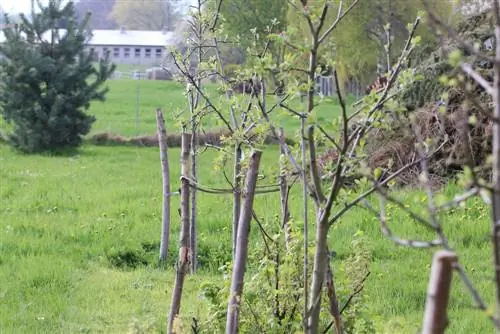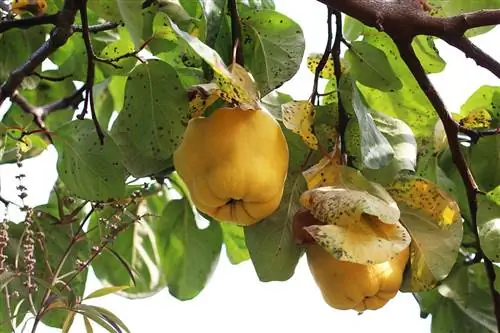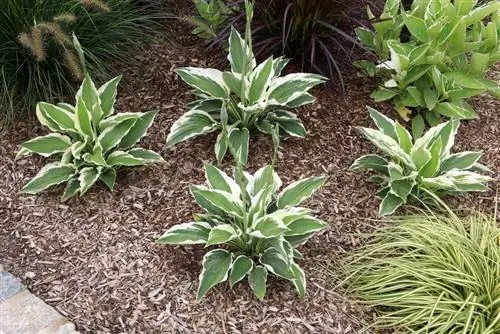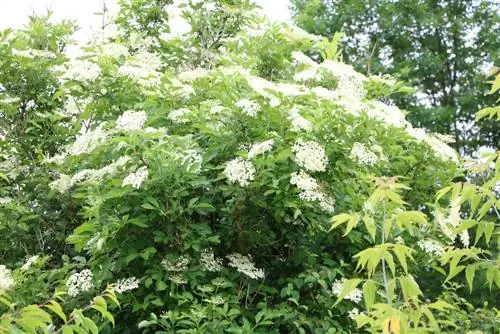- Author admin [email protected].
- Public 2023-12-17 03:39.
- Last modified 2025-01-24 12:45.
Trees are moved into tree nurseries every three to four years, in technical language called schooling. The goal is a well-rooted ball. Schooling stimulates the formation of new roots. A tree in the garden that has never been trained does not have this dense root structure. In order for a good transplant to succeed, it must be carried out with careful preparation and a lot of time.
The root system consists of main and secondary roots, which is at least the same size as the tree crown. The fine roots in the root ball absorb water and nutrients. The fine roots are shortened with a trench around the tree, the distance of which is slightly larger than the diameter of the crown. The large roots must not be damaged. These support the tree and must give it enough support in the new location.
Transplanting younger trees
If the trees are not older than about four years, they have not yet developed a widely branched root system. In the spring, before the trees sprout, the fine roots can be cut off with a circular trench around the trunk. A sharp spade is best suited for this. In order to reach the roots under the ball, they are cut off diagonally towards the trunk with the spade. The trench is filled with earth mixed with humus.
In late summer the tree can be buried in its new place. To do this, a sufficiently large hole is dug, which also leaves ten centimeters of space for fresh soil around the bale. The root ball of the excavated tree is secured with a sacking material so that it does not fall apart and fine roots can tear off. At the new location, the tree is planted just as deep in the ground as at the old one. The trunk must not be partially buried, otherwise there is a risk of rot.
If there is a risk of voles, the bale can be secured against browsing with a coarse-mesh wire net. The earth around the tree is firmly compacted so that the tree sits firmly in the ground. The tree now needs a lot of water to be able to root well. Taller trees need a stake in the main wind direction so that their root balls are not loosened from the earth in stronger winds.
Older trees need a long preparation
If the trees are older, the roots must be prepared a year in advance to ensure they grow well in the new location. The best time for this is autumn, when growth activity goes into the dormant phase. Using a spade, a trench is first dug that is slightly larger than the crown of the tree. This can be a good forty centimeters deep in order to reach all the fine roots. To ensure that as many of these roots as possible are separated under the tree, the trench below the main roots is expanded as far as possible towards the trunk.
After the trench has been filled again with a mixture of half excavation and half humus, the roots must be watered regularly and well. This causes the root system to recover and new fine roots to be formed. To prevent drying out in summer, this area can be covered with bark mulch.
In the next late summer, the root ball has recovered enough and developed new fine roots that the tree can be transplanted. For deciduous trees, the best time to do this is after the leaves have fallen. A planting hole is dug at the new location, the bottom and side walls of which are covered with a mixture of excavated soil and compost. If the soil in the new location has a different consistency, it is mixed with the soil from the old location in the planting hole.
The tree is dug up and the bale is carefully reduced to size for transport using a digging fork. Tying the branches together makes the tree more manageable when moving. The tree is placed back into the ground in the new location at the same depth as in the original location. To ensure that the trunk stands securely and straight, it is fixed with ropes attached to posts. Free spaces in the planting hole must now be filled with compost and compacted.
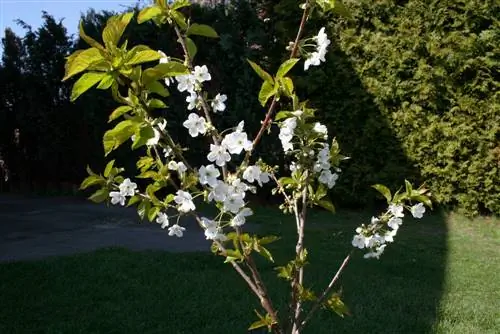
Generous watering now helps to close the last cavities in the soil. If the surface is still covered with mulch, the soil will not dry out as quickly. To compensate for lost roots, the branches are cut back. This means that less water evaporates and the roots have to absorb it.
Care and control after transplanting
The tree needs a lot of attention for the next few years. The following work must be checked and carried out again and again:
- The tree must be well protected against wind.
- Additional stakes with ropes made of natural material may be necessary, which must not become loose.
- The root area should be watered regularly and not too sparingly.
- To prevent drying out, the soil above the root area must be covered with a thick layer of bark
- It is very important to check whether the tree is developing well and normally.
- After three to four years the tree has grown
- Trees with shallow roots grow back into their new location more easily than deep-rooted ones.
- Slow-growing deciduous trees need more time to get used to after transplanting.
- Many trees can be moved with enough care.
Transplanting younger trees is a hassle-free task with good preparation and execution. The older they are, the more rooted they are in their location. In order to then move these, a greater amount of work and time is required. If in doubt, for older plants or other soil conditions, it is helpful to seek the advice of a professional who has experience with transplanting trees.
What you should know in brief
Basically any tree of any size can be transplanted. For smaller trees, a spade is sufficient, for larger trees you need heavy equipment to be able to move the trees at all. However, it doesn't work quite the same as with other plants. While you simply dig up other plants and put them back in another place, you treat trees a little more carefully. Don't just dig it up and be fine. If you want to transplant younger trees, you do this:
- The roots around the tree are cut off, slightly diagonally towards the tree.
- The tree can then be transplanted to its new location in August/September.
With older trees things look a little different:
- Here, in August, a spade-wide trench about 40 cm deep is dug around the tree (also slightly slanted towards the tree)
- and this ditch is filled with fresh earth.
- The tree can then be transplanted next spring or late next summer.
- It is particularly important to support the transplanted trees with stakes.
- These stakes give the trees support and protect them from falling over in strong winds.
- Trees need a lot of water during the growing phase. This sometimes takes 2 to 3 years.
To prevent the soil from drying out so quickly, it is an advantage to cover the tree disc with a height of about 10-15 cm with bark mulch. This protects against drying out and also keeps the ground somewhat warm and loose in winter.

